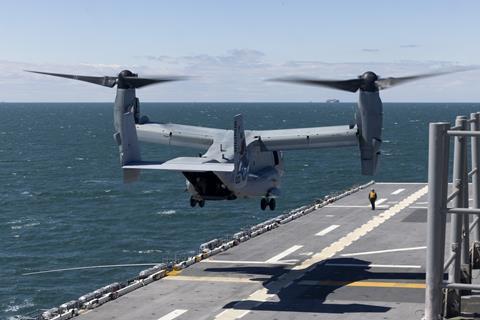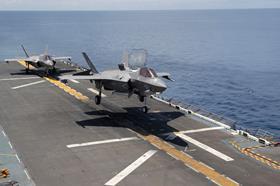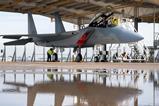Bell-Boeing V-22 Osprey tiltrotors have returned to the flight decks of US Navy (USN) ships, as operators work to recertify the transformable aircraft after a three-month grounding was lifted in March.
A US Marine Corps (USMC) MV-22 landed aboard the USS Wasp on 6 April, part of what the service describes as a “deliberate and methodical approach to returning their MV-22s to full operational capacity”.
The Wasp is a so-called amphibious assault ship – one of the USN’s light aircraft carriers designed specifically to support the USMC mission of seizing territory via amphibious landing.
Unlike the navy’s larger, nuclear-powered supercarriers that feature a catapult and arresting wire system to launch and recover aircraft, amphibious assault ships are primarily configured for rotorcraft and short take-off and vertical landing fighters like the Lockheed Martin F-35B and Boeing AV-8B Harrier II.
The recent Osprey landings took place in the Atlantic Ocean, where the Wasp is currently underway on a training mission.
Tiltrotors are an integral part of modern USMC amphibious assault doctrine, offering a long range, large troop carrying capacity and the flexibility of both vertical and horizontal flight.
The navy also uses the CMV-22B Osprey variant to resupply its aircraft carriers at sea.

However, the type had until recently been absent from flight decks – and skies altogether – after a deadly crash of a US Air Force (USAF) CV-22 last December prompted a grounding of the entire Osprey fleet.
The Pentagon lifted the grounding order in March, clearing Osprey operators to resume flight operations. In addition to the USMC, USN and USAF, the tiltrotor is also operated by the Japan Ground Self-Defense Force.
The US Naval Air Systems Command (NAVAIR), which serves as the airworthiness authority for the V-22, said on 8 March it is confident that the cause of the December crash has been identified and mitigation measures have been put in place to prevent a similar incident from occurring in the future.
“The mitigations that we’re putting in place really address this one particular component and how it operates inside of the aircraft,” said Colonel Brian Taylor, NAVAIR’s V-22 programme manager.
Notably, the fix does not involve any physical changes to the Osprey airframe or individual components – focusing instead on preventive maintenance and some changes to flight procedure.
The Pentagon has declined to reveal any specific details about the mitigation measures.

Each military service is now responsible for managing its own programme for recertifying grounded aviators and aircraft to resume operations.
With 348 MV-22s currently in its fleet, the USMC is by far the largest tiltrotor operator in the world, and appears to be moving the most aggressively to get its Ospreys flying again.
That process began with simulator training and instructor pilot flights, followed by basic flying and now more complex ship landings.
The top USMC aviation officer, Brigadier General Richard Joyce, had predicted the recertification process would take approximately 30 days for each Osprey squadron.
The 6 April MV-22 landing aboard the Wasp appears to have borne out that estimate.
While the USMC accomplished a ship-board MV-22 landing just one month after the Osprey grounding bulletin was lifted, the USN’s top aviation officer has said that service’s timeline will be more gradual.
“We expect it will be several months or more before we reach this phase,” said Vice Admiral Daniel Cheever on 8 March. Cheever is the current commander of naval air forces, commonly known as the “air boss”.
The navy has a comparatively smaller fleet of Ospreys, with just 27 CMV-22s currently in service out of a planned fleet of 44 aircraft.
Cheever noted the lengthy flights over water associated with the CMV-22’s carrier on-board delivery (COD) mission will require a longer recertification process for aircrew.
The USN has been using the nearly-retired Northrop Grumman C-2A Greyhound fixed-wing turboprop for the COD role during the Osprey grounding and recertification.































